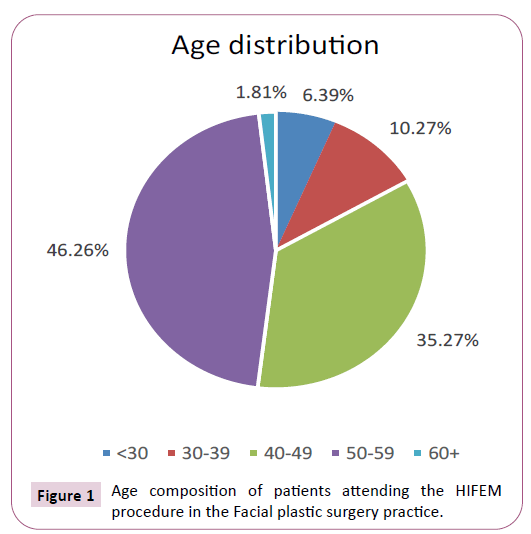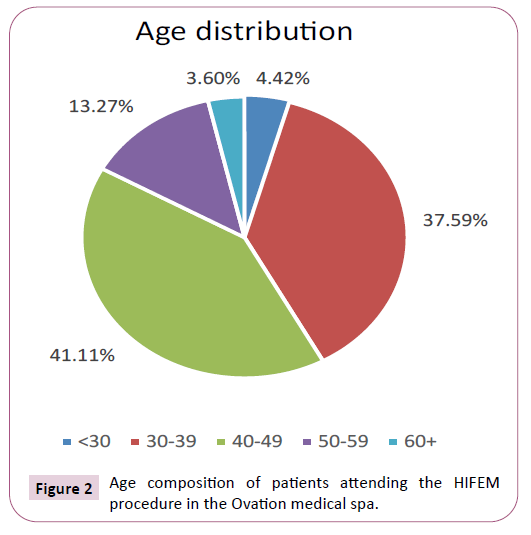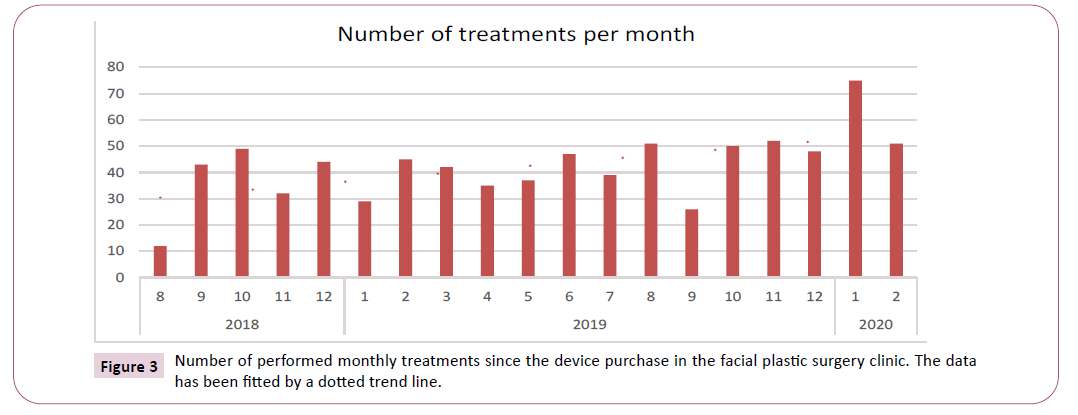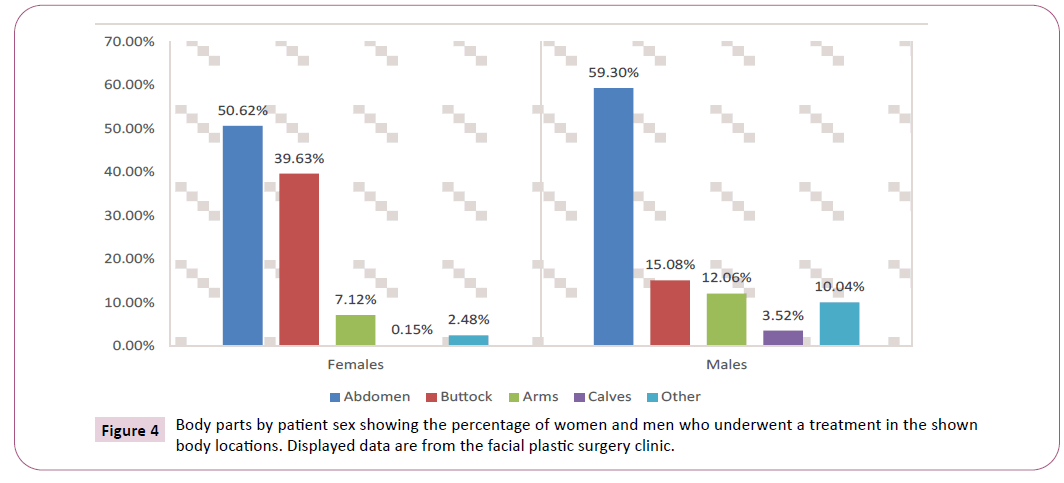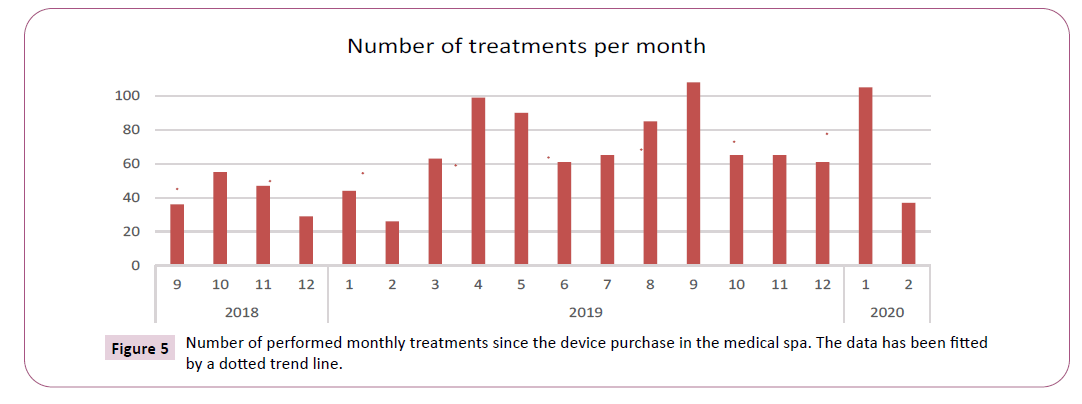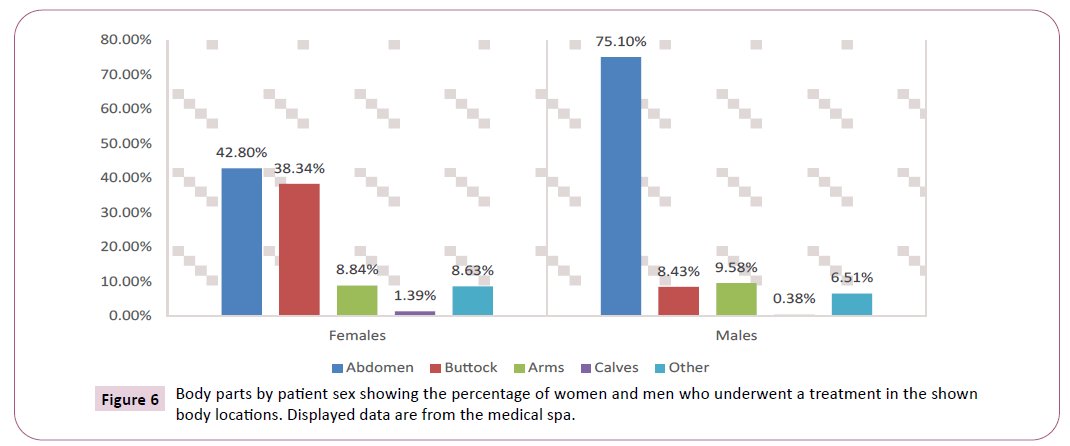Commercial and Clinical Experience with HIFEM Device in Facial Plastic Surgery and Aesthetic Medicine Practices
Michael A. Persky1* and Chris Bailey2
1Facial Plastic Surgeon, Encino, LA, California, USA
2Ovation Med Spa, Huston, Texas, USA
- *Corresponding Author:
- Dr. Michael A. Persky, M.D.
Facial Plastic Surgeon, 16311 Ventura Blvd #600
Encino, LA, California, CA-91436, USA
Tel: +1 818-918-9252
E-mail: drpersky@drpersky.com
Received Date: September 23, 2020; Accepted Date: November 17, 2020; Published Date: November 24, 2020
Citation: Persky MA, Bailey C (2020) Commercial and Clinical Experience with HIFEM Device in Facial Plastic Surgery and Aesthetic Medicine Practices. J Aesthet Reconstr Surg Vol.6 No.3:16
DOI: 10.36648/2472-1905.6.3.66
Abstract
Background and Objectives: HIFEM technology has been the first technology introduced for muscle toning. Yet, up to date the role of the technology in aesthetic practices has not been evaluated.
Methods: A retrospective review was conducted for a total of 451 patients who underwent the HIFEM procedure in between September 2018 and February 2020 in two clinics of different patient focus; facial plastic surgery and medical spa. The number of patients, performed treatments, body parts, satisfaction and procedural complications were analyzed. The commercial role within the practice was also analyzed.
Results: A total of 1969 treatments were performed over the analyzed period, which were predominantly applied to abdomen, followed by buttocks. The average age of the patients in plastic surgery clinic was 48.0 ± 8.1 and 42.4 ± 8.6 in the medical spa. Majority of the patients are females and males make up to 23% of patients in the plastic surgery clinic and up to 15% in the medical spa practice. No adverse events were reported and the patient satisfaction ranges between 90- 95%. Number of performed procedures showed consistent growth over time in both practices.
Conclusion: The results showed high efficacy of the treatments, along with high patient satisfaction. The popularity of the procedure is growing over time among both the man and women, which significantly contributes to the business growth of the practices.
Keywords
High-Intensity Focused Electromagnetic Field (HIFEM); Practice; Analysis; Commercial
Introduction
HIFEM technology has been widely investigated over the past two years since its introduction to the market in 2017 [1-9]. Both human and veterinary studies were performed and showed that the HIFEM procedure is effective for muscle thickening and strengthening [1,2,4] with a notable reduction in subcutaneous fat [1,5,6].
The subject of interest in this study is the Emsculpt device (BTL Industries Inc., Boston MA) that utilizes HIFEM technology to induce supramaximal muscle contractions, which lead to muscle hypertrophy and reduction in subcutaneous fat layer. According to the Food and Drug Administration (FDA), the device is intended to use on abdomen, buttocks, thighs, arms, and calves [10].
This manuscript aims to perform a retrospective analysis of the Emsculpt’s clinical and commercial impact on two different private practices (facial plastic surgery practice and a medical spa focusing on non-invasive aesthetic medicine) and to discuss the successful implementation of the device in these practices. The goal is to gain a better insight into how the device affects the course of the practices. The different focus of the assessed practices enables a comparison between two separate and distinct approaches in implementing the device into the existing portfolio.
Literature Review
A retrospective review was conducted on a complete set of patient data based on patients who underwent the HIFEM treatments in between September 2018 and February 2020 in a facial plastic surgery clinic (Michael A. Persky MD, FACS), as well as, the medical spa (Ovation Med Spa). Both practices purchased the device one month apart from each other. The time range thus corresponds to the first 18-19 months of the device in their practices.
Collected data includes overall statistics such as a total of treated patients, a total of performed treatments, and an average number of treatments per patient. Patient data describe age, gender, and ethnicity. The clinical set of data was analyzed for body parts distribution and their dependence on age and sex. Safety and patients satisfaction was discussed, and the commercial impact on the clinics was explored.
The facial plastic surgery clinic primarily focuses on procedures for rejuvenation and enhancement of facial appearance like otoplasty, mentoplasty, rhinoplasty and blepharoplasty. The HIFEM procedure is offered as a standalone body contouring procedure, which is part of their complementary non-surgical body contouring portfolio. The primary customers are patients who desire natural facial rejuvenation either through plastic surgery or minimally invasive procedures.
On the other hand, in the medical spa, the non-invasive body contouring procedures are a significant part of their portfolio. The HIFEM procedure is primarily offered as muscle building technology allowing patients to look, feel, and perform better and to get stronger.
In both practices, the patients schedule a consultation with the provider to discuss their goals and set realistic expectations for the treatment outcomes. The patient’s medical history is reviewed beforehand to prevent magnetic field application on patients with contraindications. Then a treatment plan is established to meet the set goals and expectations. Before the treatment, patients are instructed to hydrate and not to eat right before the procedure. Post-treatment instructions include maintaining a proper hydration level and not doing a heavy workout of the treated area on the same day.
The treatments are usually delivered twice a week, with each treatment typically lasting for 30 minutes. During the treatment, the provider is present to monitor the patient and adjust treatment settings if necessary. The procedure is not associated with any downtime. The patients thus can return to their daily activities immediately post-treatment. After completing the entire procedure, patients attend a follow-up visit about 2 to 3 months after the last treatment to discuss the patients’ outcomes and satisfaction.
Results
Patient composition
Facial plastic surgery practice: During the analyzed 18 months, a total of 166 patients underwent the HIFEM procedure in the facial plastic surgery practice. Out of all the patients treated by HIFEM, 77% were females, and 23% were males. However, the proportion of male subjects increased to 39.29% over the last three months. The average age of the patients was 48.0 ± 8.1 (males 51.9 ± 8.3, females 46.8 ± 8). The age group 50-59 was dominant among both, the female (41.07%) and male (63.68%) population, followed by the group 40-49 as 37.62% of females and 27.37% of males fell into this group (Figure 1).
Regarding ethnicity, the majority of the patients were Caucasian (85%) followed by African American (5%), Hispanic (5%), and Asian (5%). Out of all patients, 76% were existing patients to the practice who have already undergone another procedure in the past. However, 24% of patients who came to practice for the first time were attracted by the Emsculpt procedure itself.
Although the primary focus of the practice is on facial rejuvenation, body contouring procedures are also offered to the patients. As such, Emsculpt is primarily used as a standalone treatment; however, it is also used in conjunction with cryolipolysis to fruther enhance the results.
Medical spa: In the aesthetic clinic, a total of 285 patients received the full HIFEM treatment cycle with the Emsculpt device during the examined 18 months. The majority of the patients were females, representing 85.4% of all patients, while males comprised 14.6% of the entire treated patient group.
The average age of all treated subjects was 42.4 ± 8.6 (females 41.7 ± 8.4, males 46.1 ± 9.3). As shown in Figure 2, most of the patients (79%) were in the mid-age range 30-49 as 41% of the patients fall into the group 40-49, and 38% of patients between 30 and 39 years of age.
Among females, the age-layout was similar to that of the entire patient population, as 41% of patients were from the age group 40-49, 40% were of age between 30 and 39, and 9% were females from age range 50-59. Only 4% and 5% of female patients were younger than 30 and older than 60 years, respectively. Among males, on the other hand, the most frequent age groups were 40-48 (38%) and 30-39 (37%), followed by the age group 30-39 (25%). Altogether, only 1% of males were younger than 30 or older than 60 years.
Patients of all ethnic groups underwent HIFEM procedure in the clinic, with a majority being Caucasians (70%). African Americans were the second most frequent group (15%), followed by Hispanic (10%) and Asians (5%). Patients with all skin types 1-6 were treated.
Clinical data
Facial plastic surgery: The evaluation of clinical data showed that over the analyzed period, 828 treatments were performed using the HIFEM device. As shown in Figure 3, the monthly number of treatments was fairly consistent over time without any significant fluctuation. However, consistent growth in monthly treatments was observed over the time when comparing the average number of monthly treatments in the first six months (Aug 2018 – Jan 2019) with the last six months (Oct 2019 – Feb 2020) as the number of monthly treatments increased by 42.9% from 35 to 50 years.
Although the recommended treatment protocol consists of 4 treatments, the practice usually provides five treatments as a part of the whole treatment procedure. The procedure was predominantly applied to the abdomen (52.54%), followed by buttocks (34.18%) and arms/calves (8.94%). Other body parts, referring to thighs and other off-label uses, were treated in 4.35% of cases.
However, small applicators intended for the use on arms and calves were purchased in August 2019. Since then, the arms and calves treatments comprised monthly 20.3% of all performed treatments on average.
Taking gender into account, abdominal treatments were the most popular for both men and women, followed by the buttock treatments. However, buttock treatments were more prevalent among female patients (39.66%) compared to male patients (15.79%). Detailed results can be seen in Figure 4.
In regards to age, an interesting trend can be seen in the youngest group of age 30 and below, where the buttock and abdominal treatments were used equally (both 47.17%). Arm treatment, on the other hand, was the most popular procedure in the age group 50-59.
Medical spa: According to clinical data, 1141 treatments with the HIFEM device were performed over the analyzed 18 months. Figure 5 shows that since the purchase of the device, the average number of monthly treatments has grown steadily over the first eight months and then fluctuated above 60 treatments per month since then. When comparing the first six months since purchase (Sep 2018 – Feb 2019) with the last six examined months (Sep 2019 - Feb 2020) the average monthly treatments increased by 89.7% from 39 to 74.
The treatment protocol of the practice usually consists of 4 treatments for all body parts; abdomen, buttocks, thighs, arms, calves. In some cases, the protocol is extended up to 6 treatments. The abdominal application was the most popular procedure among the patient population within the 18 monitored months, as 46.3% of all performed procedures were applied to the abdomen. Buttock treatments were performed in 33.1% of cases; arm and calf treatments were administered in 11.6% and 1.7%. Other body parts such as thighs and other off-label uses were treated in 7.4% of the treatments.
The clinic purchased the small applicators only in July 2019, and the treatments of arms and calves quickly become popular as the proportion of arm and calf treatments since the purchase was 22.8% each month on average.
The assessment of the differences in body part popularity between males and females showed that abdominal procedures were the most frequently performed procedures in both genders. However, the proportion of buttock treatments is significantly higher among females (38.3%) than in males (8.4%), who also tend to prefer other body part procedures such as thighs and arms. The popularity of arm procedure among females appears to be related to age as the proportion of the treatments grew with age. Among millennial females, buttock procedures were performed only in 22.1%, while women aged 40 and higher were above 38.2%. See Figure 6 for detailed body part treatment distribution among males and females.
Safety and patient satisfaction: In both practices, the patients were constantly monitored for adverse events or complications during the treatment and follow-up period. No adverse events/ complications or safety concerns were reported during the analyzed period in any of the two practices. Some patients reported mild muscle fatigue comparable with post-exercise soreness.
The treatments were mostly perceived as tolerable and not painful, although some patients found the strong muscle contractions slightly uncomfortable. The patients tolerated the 100% device intensity in 98% of cases.
In the facial plastic surgery practice, the treatment was found efficient in 83% cases, with a satisfaction rate of 90%. As expected, there were a few patients who were dissatisfied with the treatment outcomes. These patients were provided additional treatments and unlimited treatment at a discounted cost. After additional treatments, the patients were subsequently satisfied.
In the medical spa, the treatments were considered highly efficient (94%), with high patient satisfaction of up to 95% of all cases. This can be documented by the fact that after the first procedure, many patients purchase multiple packages for additional body parts. For a few instances of dissatisfied patients, additional treatments, or an alternative treatment plan was offered.
No system malfunctions occurred in any of the practices. There were no hardware or software related issues that occurred despite the extensive use of the device.
Commercial analysis
Facial plastic surgery: The practice purchased a single Emsculpt device in August 2018 with the large applicators intended for abdominal and buttock treatments. In August 2019, the Emsculpt system was expanded by purchasing small applicators intended for the arms and calves. Small applicators increased the procedural portfolio, and since the purchase, the treatments performed monthly increased by 42.8%.
In general, the device is offered as a muscle-building, noninvasive, safe, and effective treatment with a welcome side effect; loss of unwanted fat. Due to the massive promotion of Emsculpt on a national level, the practice did not invest large amounts into marketing. Instead, it used a small number of funds in the local print magazine and Facebook ads. The practice is also very active on social media such as Twitter, Instagram, and Facebook used to promote the practice and the procedures.
For patients who have already undergone the procedure, the practice offers a membership that allows them to come in for maintenance treatments at a discounted price. This membership program increases patient satisfaction as the achieved results are preserved for a longer time and generate additional revenue for the practice.
The main expenses related to the Emsculpt device are, therefore, leasing and replacement of expired applicators. An average treatment cost for a single treatment is $750. The overall expenses on the treatment, including staff’s time, office space, and applicator replacement make up to 30% of the treatment price. The remaining 70% represents a net profit. The capital investment on the device purchase was thus recovered within 9 months.
Medical spa: The practice purchased the device only with the large applicators for buttock and abdominal treatments in September 2018. Due to the high demand for the Emsculpt procedure, 399 treatments were performed during the first 8 months.
The treatment was promoted on social media, e-blast, and PPC marketing. Over time, the HIFEM device became an important part of the practice portfolio. It is also offered in combination with radiofrequency and cryolipolysis based procedures. To further enhance the interest in the treatments a special offers such as “Get one free cycle of cryolipolysis with a 4 treatment series of HIFEM or two free cycles with a 6 treatment series” are being offered to the patients.
Regarding the financial aspects of the procedure, the average cost for a single treatment is $1000; however, if purchased as a whole package (4 treatments), the price of a single treatment is discounted at $750. The overall expenses per treatment were calculated to range between 20 and 25% of the procedure price. Taking these into consideration, the device was thus paid off within 4 months since the purchase. Additional treatments then generated a significant net profit allowing for further development of the practice to stand up to its innovative reputation.
Discussion
The study analyzed the role of the Emsculpt device in two practices that focused on different types of patients and its commercial impact on the practices. While in the facial plastic surgery practice, the HIFEM procedure by Emsculpt is rather a complementary procedure extending the practice’s portfolio for their clients, in the medical spa, body contouring by HIFEM is one of the major tools used to achieve non-invasive aesthetic improvements in their clients. The number of treated patients demonstrates the difference in the role of the device in each practice. In the plastic surgery clinic, a total of 166 patients were treated during analyzed 18 months, while in the medical spa, 285 patients were treated.
The number of treatments in both practices kept increasing during the first year after the purchase. This trend could be attributed to the fact that the device itself was first introduced only in April 2018. The overall awareness about the procedure was thus growing as the device was gaining more and more interest over time. Another aspect could be that the practices were first looking for the best implementation of the device among their existing portfolios. Due to its unique effect on muscles, the procedure quickly found its unique place in the practice as it could be used as a standalone procedure and can also be used in combination with solely fat reduction devices such as cryolipolysis or radiofrequency.
In the presented data, an exciting trend of high interest among the male patients toward the HIFEM procedure can be seen, who make up to 23% of patients in the plastic surgery clinic and up to 15% in the medical spa practice. We believe that reason is that for male patients, the muscle strengthening and toning effect delivered by the HIFEM procedure is much more attractive than skin rejuvenation or fat removal, the traditional aesthetic interventions. In both practices, a large group of male patients was interested in abdominal application followed by application to arm muscles biceps brachii and triceps brachii. In both clinics, the extension of the system by small applicators led to an increase in the number of performed treatments. The procedures performed by these applicators made up 22.8% and 20.3% of all performed procedures in the medical spa and plastic surgery clinic, respectively.
The treatments are usually perceived as comfortable with a high satisfaction rate, which further increases the popularity of the procedure among patients, who can see significant improvement and the physicians whose reputation is growing. High popularity then makes the procedure also commercially interesting for the practices. Even if the system is used as a complementary tool within the portfolio, the expenses related to the device purchase may be recovered within 9 months. If used most widely, the initial expenses may be paid off as fast as 4 months, depending on the practice’s strategy.
Only two practices were analysed in the present study, which is the major limitation of the study. The results thus do not represent a situation on the entire market but rather show an example of how the device can be implemented in two different types of practices along with the impact on the practices. Furthermore, the study followed the use of the device for 18-19 months. A longer analysis was not possible due to the novelty of the procedure, but would be beneficial in the future to capture the seasonal trends and to monitor the usage and development of the device in the practice. Lastly, the analysed data may not be affected solely by the popularity of the procedure, but other factors such as economical situation in the country or the general state of aesthetic medicine may play a role. However, the presented data do illustrate how well the device can be adopted in the practice and shows a first evidence of its growth in the first months since introduction to market.
Conclusion
This retrospective patient chart review of HIFEM procedure in facial plastic surgery clinic and medical spa showed a safety profile of the procedure as no adverse events or complications were observed. The results showed high efficacy of the treatments, along with high patient satisfaction. The popularity of the procedure is growing over time among both the men and women, whom we believe significantly contributes to the business growth of the practices. Thus, we consider body contouring with the Emsculpt device to be safe and highly effective for the patients as well as commercially attractive for the practices.
Disclosure of Interest
Michael A Persky MD and Chris Bailey MD have no relevant conflicts to declare and have no financial interest to declare in relation to any of the products or device mentioned in this article.
References
- Kent DE, Jacob CI (2019) Simultaneous changes in abdominal adipose and muscle tissues following treatments by high-intensity focused electromagnetic (hifem) technology-based device: Computed tomography evaluation. J Drugs Dermatol 18(11): 1098–1102.
- Kinney BM, Lozanova P (2019) High intensity focused electromagnetic therapy evaluated by magnetic resonance imaging: Safety and efficacy study of a dual tissue effect based non-invasive abdominal body shaping. Lasers Surg Med 51(1): 40-46.
- Kinney BM, Kent DE (2020) MRI and CT assessment of abdominal tissue composition in patients after high-intensity focused electromagnetic therapy treatments: A one-year follow-up. Aesthet Surg J 2: 1.
- Duncan D, Dinev I (2020) Noninvasive induction of muscle fiber hypertrophy and hyperplasia: effects of high-intensity focused electromagnetic field evaluated in an in-vivo porcine model: A pilot study. Aesthet Surg J 40(5): 568-574.
- Weiss RA, Bernardy J (2019) Induction of fat apoptosis by a non-thermal device: Mechanism of action of non-invasive high-intensity electromagnetic technology in a porcine model. Lasers Surg Med 51(1): 47-53.
- Halaas Y, Bernardy J (2020) Mechanism of nonthermal induction of apoptosis by high-intensity focused electromagnetic procedure: Biochemical investigation in a porcine model. J Cosmet Dermatol 19(3): 605-611.
- Busso M, Denkova R (2018) High-Intensity Focused Electromagnetic (HIFEM) Field Therapy Used for Non-Invasive Buttock Augmentation and Lifting: Feasibility Study. J Aesthet Reconstr Surg 5(1): 2.
- Jacob CI, Paskova K (2018) Safety and efficacy of a novel high‐intensity focused electromagnetic technology device for non-invasive abdominal body shaping. J Cosmet Dermatol 2:1.
- Jacob C, Kinney B, Busso M, Chilukuri S, McCoy JD, et al. (2018) High Intensity Focused Electro-Magnetic Technology (HIFEM) for non-invasive buttock lifting and toning of gluteal muscles: A multi-center efficacy and safety study. J Drugs Dermatol 1;17(11): 1229-1232.
- U.S. Food and Drug Administration (2018) Premarker Notification: K180813 510(k).
Open Access Journals
- Aquaculture & Veterinary Science
- Chemistry & Chemical Sciences
- Clinical Sciences
- Engineering
- General Science
- Genetics & Molecular Biology
- Health Care & Nursing
- Immunology & Microbiology
- Materials Science
- Mathematics & Physics
- Medical Sciences
- Neurology & Psychiatry
- Oncology & Cancer Science
- Pharmaceutical Sciences
